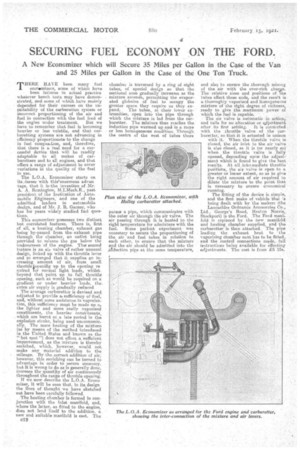SECURING FUEL ECONOMY ON THE FORD.
Page 16

If you've noticed an error in this article please click here to report it so we can fix it.
A New Economizer which will Secure 35 Miles per Gallon in the Case of the Van and 25 Miles per Gallon in the Case of the One Ton Truck.
THERE HAVE been many fuel econornizees, some of which have been failures in actual practice whatever bench tests may have demon.strated, mid some of which have mainly depended for their success on the unsuitability of the carburation system or incorrect proportioning of the air and fuel in connection with the fuel feed of the engine under treatment. But we have to remember that fuel is becoming heavier or less volatile, and that carburetting systems are not advancing in
efficiency proportionate to the change in fuel composition, and, therefore, that there is a real need for a suc cessful device that will be readily adaptable to all makes of car buretters and to all engines, and that offers a range of adjustment to cover variations in the quality of the fuel in use.
The L.O.A. Economizer starts on its,Lreer with thistenorroous advan
tage, that it is,the invention of .Mr. A. A. Remington, M.I.Meeh.E., past
president of the Institution of Automobile Engineers, and one of the admitted leaders in automobile design, and of Mr, 3. R. Garner, who . has for years widely studied fuel questions.
This economizer possesses two distinct but correlated features. There is, first of all, a heating chamber, exhaust gas being by-passed from the exhaust pipe through the chamber, an outlet being provided to release the gas below the underscreen of the engine. Theo second feature is an air valve of rather unusual. design, linked up with the throttle lever and so arranged that it supplies an increasing amount of air, from small throttielopenifig up to the opening re reaired for normal light loads, whilst. beyond that point up to full throttld opening, such as would be required on a gradient or under heavier loads, the. extra air supply is gradually reduced The average carburetter is devised and adjusted to provide asufficiency of itrel, and, without some assistance in vap-orizadon, this sufficiency must be made up thelighter and more -eaeily vaporized eonetituents, . the heaviesconstituents, which are burnt at a late peried in the explosion stroke, being used uneconomically. The mere• heating of the mixture (as by means of the method introduced in the United States and known as the " het spot ") does not effect it sufficient improvement, as the mixture is thereby enriched, which, however, would not, make any matelial addition to the mileage. By the .correct addition of air, however, this enriching can be turned to advantage in order to secure economy, but it is wrong to.do as is generally done, increase the quantity of air continuously throughout the ranke of throttle opening.
If we now describe the L.O.A. Econo mixer, it Trill be seen that, in it& design the lines of thought we have sketched out have been carefully followed. The heating chamber is formed in conjunction with the inlet manifold, and, where the latter, as fitted to the engine, does not lend itself to the addition, a new and suitable manifold is cast. The C1.2 chamber is traversed by a ring of eight tubes, of special design so that tho sectional area, gradually increases as the mixture ascends, permitting the evaporated globules of fuel to occupy the greater space they require as they ex
pand. The tubes, at their lower extremities, open into the pipe through which the mixture is led from the carburetter. The mixture thus reaches the induction pipe warmed up and in a more or less homogeneous condition. Throqh, the centre of the nest of tubes there passes a pipe, which communicates with the outer air through the air valve. The air passing through it ia heated to the right temperature for admixture with the fuel. Some patient experiment was necessary to secure the proportioning of the air and fuel tubes in relation to each other, to ensure that the mixture and the air should be admitted into the ..iri.duction pipe at the same temperature,
and aisle to ensure the thorough mixing of the air with the over-rich charge. The relative sizes and positions of the tubes effect these ends, and the result is a thoroughly vaporized and homogeneous mixture of the right degree of richness, ready to give the maximum power of which the fuel is capable. The air valve is automatic in action, and 'calls for no alteration or adjustment after its first setting. It is connected with the throttle • valve of the car
buretter,so that it is antuated in unison with it. When the throttle valve is closed, the air inlet to the air valve is also closed, as it is (or nearly so) when the throttle valve is fully opened, depending upon the adjustment which is found to give the best results. At all intermediate throttle positians, the air valve is open to a greater or lesser extent, so as to give the right amount of air required to dilute the mixture to the point that
is necessary to ensure -economical running. The fitting of the device is simple, and the first make of vehicle 'that is being dealt with by the makers (the Lancashire Ordnance Accessories Co., Ltd., George's Road, Heaton Norris, Stockport) is the Ford. The Ford marli fold is replaced by the new manifold and heating chamber supplied, and the carburetter is then attached, The pipe leading the exhaust heat to the vaporizing chamber next has to be fitted, and the control connections made, full iestructions• being available for effecting adjustments. The cost is from 15s.
































